How to Avoid Building a Big Sales Infrastructure and Still Grow Your Company

Part of growing a company is growing a sales team.
Stop me if you’ve heard this story before: a moderately successful company decides it’s time to pour gas on the fire and establish an outbound sales team. So, they hire a couple of reps and have some success. To continue that trend, they hire a few more reps. And then a few more.
You get the picture.
But, what about those organizations that never plan to build and grow a robust sales infrastructure? How do those companies grow their bottom line?
By building strategic partnerships that will refer to new business, that’s how.
“We have a network of strategic partners that serve the same kind of customers, just at different points in the sales cycle. For example, we partner with investment bankers and attorneys because they are key participants with our clients,” says Jennifer Peek, Founder and CEO of Peek Advisory Group, on a recent edition of The Predictable Revenue Podcast.
Our clients are either buying or selling a business.I started trying to find those business owners directly myself. But, in our sales cycle, we are a support function to the transaction – people were coming into the pipeline at a different spot than looking for us. That took a lot of education and it was hard to maintain. So, we shifted. We formed partnerships with other providers. We can help each other. They don’t have our expertise, and we don’t have theirs.
Finding partners
Peek says the consulting services Peek Advisory group offers – financial services for the mergers and acquisition process of small to mid-size companies – were difficult to explain or convince business owners of their need. Ofsten, she says, business owners would default to saying they already had an investment banker or attorney, so Peek Advisory Group’s services were redundant.
Naturally, that wasn’t the case – so Peek took a more B2B approach with her outreach, and started contacting the very same bankers and attorneys that those business owners used.
“Those conversations with business owners were a huge clue in how we needed to plug ourselves into a funnel and find partners,” says Peek.
Sure, nurture sequences can help, but what worked better was to go straight to attorneys or investment bankers.
When reaching out to establish strategic partnerships, however, some tried-and-true sales tactics don’t hurt. For example, crafting a range of case studies and nailing your niche.
“Getting as much concrete evidence to demonstrate your value is helpful. That was huge for us, especially in the form of case studies. That’s a key element in any service industry,” says Peek.
And make sure you have a range of case studies to make sure you are aligned with the other services that work with the same types of clients. For us, that’s manufacturing, distribution, and construction. We got pretty specific about what we do, and who we should partner with.
(Editor’s note: we had Johann Nogueira on the pod a while back to discuss finding hidden revenue in your demand generation pipeline. You can read about our chat here, or listen to the whole podcast here)
Does building a relationship improve the speed of the sale?
In short, yes. This is a huge benefit to this strategic partnership model – when your services are needed and a referral is made, the sales cycle can be quite short.
“When a partner tells someone to call Jennifer, they usually get moving pretty quickly. So, that can be great. In some cases, customers are just doing their research, so we win some, and some we don’t,” explains Peek.
But when the need is there, and through a partner’s sales process, our services have been outlined – that’s a great thing.
Once a relationship is built, of course, it has to be maintained. For instance, a company may change its services over time, and contacts move to different firms. When such things happen, it’s critical to make sure you’re on top of it.
Never discount the importance of regular communication – of over communicating, in fact. It’s communication that spans the entire length of a business relationship
“We make sure we’re doing quarterly outreach, whether it be emails, lunches, or coffees,” says Peek.
When partners or contacts change firms, we have to know. We make sure we’re aware of people moving around, and reaching back out when that happens. We may be able to expand with that connection at their new organization.
Doing great work
Finally, it helps to do great work. Afterall, your partners depend on it – don’t forget, they’re putting their names on the line for you. And, moreover, your reputation grows. Your contacts speak with others all the time – don’t think that your name doesn’t get mentioned when they’re talking.
And, this ties back to the importance of case studies as well – the more critical content you produce, the better you describe your services, and the more clear your niche is, the chances of others reading that content and realizing they need your services increases.
“I have people cold call me with reports I have done. So, people get that work and compliment us, and refer us,” says Peek.
Certainly, this happens and doing great work is the basis. When you do good work, people come back to you and it is easy for them to recommend you as a resource. When you do great work, that’s what happens.
For more of Peek’s thoughts on partnerships and relationship-building, check out the rest of her interview on The predictable Revenue Podcast.
NO TIME TO READ?
Listen On:


